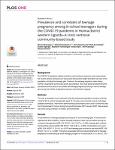| dc.contributor.author | Musinguzi, Marvin | |
| dc.contributor.author | Kumakech, Edward | |
| dc.contributor.author | Auma, Anne Grace | |
| dc.contributor.author | Akello, Ruth Anne | |
| dc.contributor.author | Kigongo, Eustes | |
| dc.contributor.author | Tumwesigye, Raymond | |
| dc.contributor.author | Opio, Bosco | |
| dc.contributor.author | Kabunga, Amir | |
| dc.contributor.author | Omech, Bernard | |
| dc.date.accessioned | 2022-12-19T14:00:44Z | |
| dc.date.available | 2022-12-19T14:00:44Z | |
| dc.date.issued | 2022 | |
| dc.identifier.citation | Musinguzi M, Kumakech E, Auma AG, Akello RA, Kigongo E, Tumwesigye R, et al. (2022) Prevalence and correlates of teenage pregnancy among in-school teenagers during the COVID-19 pandemic in Hoima district western Uganda–A cross sectional community-based study. PLoS ONE 17(12): e0278772. https://doi.org/10.1371/ journal.pone.0278772 | en_US |
| dc.identifier.uri | https://doi.org/10.1371/ journal.pone.0278772 | |
| dc.identifier.uri | http://ir.lirauni.ac.ug/xmlui/handle/123456789/457 | |
| dc.description.abstract | Background
The COVID-19 pandemic related restrictions and lockdown measures had compromised
the routine delivery and access of sexual and reproductive health and rights services to the
population including the teenage girls. However, the teenage pregnancy rates during
COVID-19 pandemic period were poorly documented. This study aimed at determining the
prevalence and the factors associated with teenage pregnancy among in-school teenage
girls during the COVID-19 pandemic period in Hoima District Uganda.
Methods
This was a descriptive cross-sectional study that employed quantitative research methods.
A total of 314 in-school teenage girls aged 13–19 years were selected using a multi-stage
sampling techniques. Interviewer-administered questionnaires were used to collect the data
from the participant’s homes during the period December 2021-January 2022. Data analysis
was done using univariate, bi-variate, and multivariate.
Results
The prevalence of teenage pregnancy among the in-school teenage girls in Hoima district
Uganda was 30.6% [96/314]. Higher teenage pregnancy rates were prevalent among the
unmarried teenage girls [aOR: 9.6; 95%CI: 4.64–19.87; p = 0.000], teenage girls studying
from boarding schools [aOR 2.83, 95%CI 1.36–5.86, p = 0.005], contraceptive non-users
[aOR: 2.54; 95%CI: 1.12–5.4; p = 0.015] and teenage girls involved in sex trade [aOR 3.16,
95%CI 1.5–6.7, p = 0.003]. The factors associated with the reduced likelihood for teenage
pregnancy included being an adult teenage girl aged 18–19 years [aOR: 0.15; 95%CI: 0.07–0.32; p = 0.000] and not receiving sex education during the period [aOR 0.36, 95%CI 0.13–
0.62, p = 0.024].
Conclusion
The results indicated that 3 out of 10 in-school teenage girls from Hoima district Uganda got
pregnant during the COVID-19 pandemic period of 2021. Teenage pregnancy was prevalent
among teenage girls who don’t use modern contraceptive methods and those involved in
sex trade. Teenage pregnancy was however, less prevalent among adult teenage girls aged
18–19 years. The findings point to the need for health stakeholders to innovate creative policies,
contingency plans and programmes aimed at delaying age for sexual activities,
increasing contraceptive use and minimizing pregnancy risk from sex trade among in-school
teenage girls during COVID-19 pandemics. | en_US |
| dc.language.iso | en | en_US |
| dc.publisher | PLoS ONE | en_US |
| dc.subject | COVID-19 pandemic | en_US |
| dc.subject | Hoima District | en_US |
| dc.subject | Teenage pregnancy | en_US |
| dc.title | Prevalence and correlates of teenage pregnancy among in-school teenagers during the COVID-19 pandemic in Hoima district western Uganda–A cross sectional community-based study | en_US |
| dc.type | Article | en_US |

